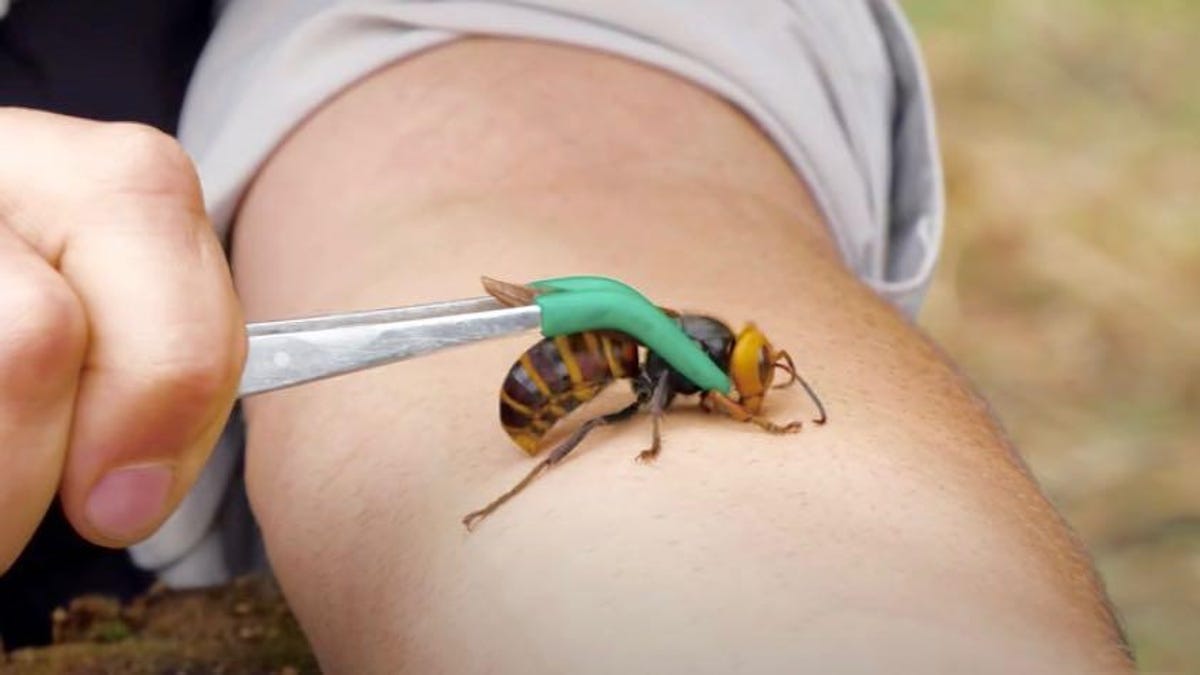Murder hornets are killing off bees and invading our nightmares
What's up to 2 inches long and likes to decapitate bees? Say hello to the Asian giant hornet, now spotted in North America.
If you didn't think 2020 could get much worse, it just did with the invasion of murder hornets.
The Asian giant hornet (vespa mandarinia) is described as 1.5 inches to 2 inches in length with an orange-yellow head and black stripes on its abdomen.
Kyoto Sangyo University researcher Jun-ichi Takahashi said the hornet species earned its "murder hornet" nickname due to its toxic venom, which is equivalent to that of a venomous snake, according to a New York Times piece on Saturday that got social media talking about the horrifying pest. Multiple stings from this large hornet can be fatal. So much so that hornets kill up to 50 people a year in Japan alone.
And now they're in the United States.
The large hornets were first seen in the US in December in Washington, Washington State Department of Agriculture verified. It's not known how the giant hornets first arrived in North America, but insects often hitch a ride to other countries via international shipping boats and other transportation. So far, the hornet sightings have been limited to the Pacific Northwest.
We've had lots of questions about how Asian giant hornets compare in size to other similar-looking insects. Check out our new to-scale size comparison to see!
— WA St Dept of Agr (@WSDAgov) April 29, 2020
You can download a pdf of this image at https://t.co/cz5MK9SExt#asiangianthornet #invasivespecies pic.twitter.com/i6CXnT03eC
Originally from eastern and southeast Asia, the giant hornet eats other insects like wasps and bees. In fact, the hornet is known for wiping out full colonies of honeybees, which is alarming since bee populations are already in decline, putting them on endangered lists.
Just a few Asian giant hornets can destroy a honey beehive in a matter of hours. The large hornets use their spiked mandibles to rip the heads off the bees, then eat the bee thoraxes.
If that's not horrifying enough, the Asian giant hornet's stingers are long enough to poke through beekeepers' suits that usually protect humans from bee stings.
In 2018, YouTuber Coyote Peterson -- known for letting insects bite and sting him on purpose -- showed what it feels like to be stung by the hornet when he was visiting Japan. Spoiler alert: The hornet's stinger gets stuck in his skin as it pumps venom into his arm.
According to the WSDA, which has been actively monitoring the insect's activities, the Asian giant hornet stinger is longer than that of a typical wasp. It can sting several times. And even a single sting can deliver a large dose of venom that can damage skin tissue.
If you want to avoid getting stung by the Asian giant hornet, WSDA has a few suggestions. While these hornets don't generally attack people or pets, they can attack when threatened or when protecting their nest. So don't rely on typical beekeeping protective clothing as it's not sufficient to protect from stings.
WSDA has new resources available on the #AsianGiantHornet, including tips on
— WSU WSPRS (@PICOL_mgr) April 14, 2020
trapping at https://t.co/2v4dnHOkU5.
Find lots more on the WSDA Asian giant hornet page (https://t.co/oyUDMWpAdy). AGH Fact Sheets (like this one) are in Additional Resources.#InvasiveSpecies pic.twitter.com/QCgbEItOeY
If you find a colony, don't attempt to remove or destroy it. Report it to WSDA or your local agricultural department immediately. And it goes without saying that if you are allergic to bee or wasp stings, never approach the Asian giant hornet.
Of course, with a nickname like murder hornet, plenty of people shared their terror of the insect.
"Murder hornets. Sure thing, 2020. Give us everything. Hypno-frogs. Fecal blizzards. Toilet tsunamis. A Cats sequel. We can take it," comedian Patton Oswalt tweeted on Saturday.
Tweeted writer/producer Ben Wexler, "I distinctly remember, a week ago, saying 'Well at least there are no murder hornets,'"
Murder hornets. Sure thing, 2020. Give us everything. Hypno-frogs. Fecal blizzards. Toilet tsunamis. A CATS sequel. We can take it. https://t.co/DSDpgKhKzQ
— Patton Oswalt (@pattonoswalt) May 2, 2020
I distinctly remember, a week ago, saying “Well at least there are no murder hornets”
— Ben Wexler (@mrbenwexler) May 2, 2020
Oh sure, we can all go outside after Quarantine is over, but... the murder hornets. pic.twitter.com/rZjPxfd0Rn
— Dan Ashley (@Ohcanadan) May 2, 2020
I hope there’s a window between the covid-19 quarantine and the murder hornets finishing us off for a minor league baseball team to name itself the Murder Hornets.
— southpaw (@nycsouthpaw) May 2, 2020
We had murder hornets for maybe 10 minutes and now we already have ROBOT MURDER HORNETS!!!
— Dane Cook (@DaneCook) May 2, 2020
2020 let us catch a breath!! pic.twitter.com/vrGRbkzZnl
Where was “Murder Hornets” when we were choosing my son’s soccer team name!
— devon sawa (@DevonESawa) May 2, 2020
"Murder hornets arrived in a America"
— N1v30 (@n1v30) May 2, 2020
Everybody: pic.twitter.com/hx8ceZ4M6c
It’s month #5 of the year,
— Limericking (@Limericking) May 2, 2020
And murderous hornets are here,
Beheading their prey
And growing in sway.
Their motives, as yet, are unclear.


